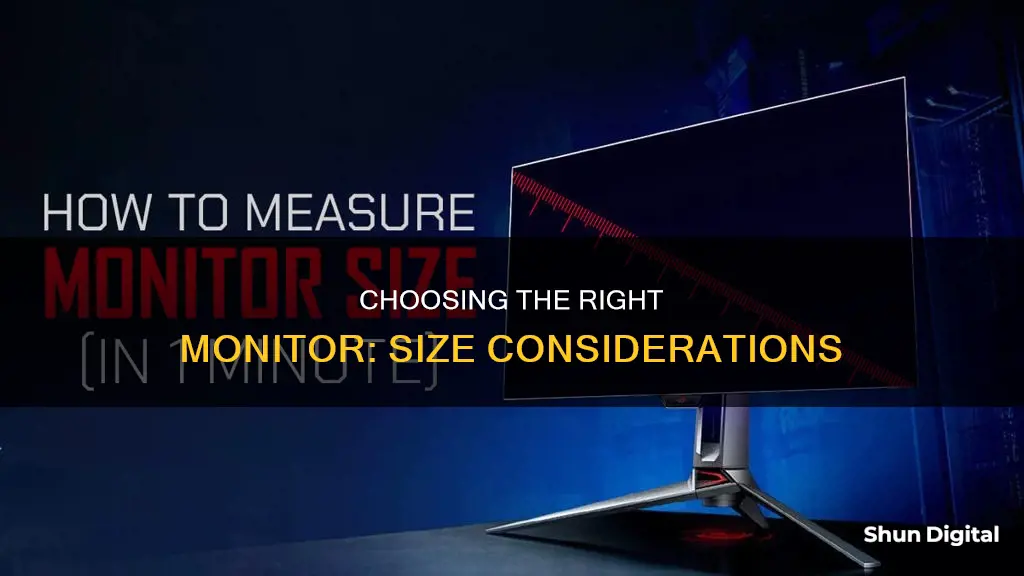
Choosing the right monitor size depends on several factors, including intended use, resolution, and desk space. For example, gamers tend to prefer larger monitors with higher refresh rates, such as 27-inch screens with 1440p resolution or 4K resolution. In contrast, those primarily using their monitors for typing or writing may opt for smaller screens, as lower screen sizes and frame rates do not hinder these activities. Additionally, the available desk space will influence the monitor size, as larger monitors may not fit on smaller desks without requiring the user to sit too far away, which can cause eye strain. Therefore, it is essential to consider the intended use, resolution requirements, and available space when selecting a monitor size to ensure optimal comfort and functionality.
| Characteristics | Values |
|---|---|
| Purpose | Gaming monitors require a higher frame rate and can support 60 fps or 4K resolution. For typing, a lower frame rate and smaller screen size are sufficient. |
| Distance from the screen | The guideline for determining monitor size is 1 foot of distance for every 7 inches of the monitor. For example, a 21-inch display should be placed 3 feet away from the user. |
| Screen size | 24-inch monitors have long been considered the baseline. 27-inch monitors are now recommended for most users. 32-inch monitors are typically reserved for unusually large desks or corner setups. |
| Resolution | 1080p is ideal for monitors up to 25 inches; 1440p is ideal for 27-inch monitors, and 4K is great for 30-inch monitors and above. |
| Aspect ratio | The standard aspect ratio is 16:9. Ultrawide monitors have aspect ratios of 21:9 or 32:9. |
| Ports | Most monitors have HDMI and DisplayPort connections. USB-C and Thunderbolt connections are more expensive but allow a single-cable connection to modern laptops. |
What You'll Learn

Monitor size depends on resolution
When it comes to choosing a monitor, size and resolution go hand in hand. The right combination of the two will ensure you get the optimal viewing experience for your needs.
For example, a 27-inch monitor is a popular choice for many, but the resolution you opt for will determine how close you can sit to the screen. A 27-inch monitor with a 1080p resolution will result in a pixelated picture, so you'll need to position yourself further away, whereas a 27-inch monitor with a 4K resolution will allow you to sit closer without the image appearing blurry or pixelated.
If you're a gamer, a 24-inch monitor is a good size for competitive gaming as you'll easily be able to view the entire screen without moving your neck. A resolution of 1080p is standard for this size monitor and will provide a smooth gaming experience.
For a more immersive gaming experience, a larger monitor is a better choice. A 27-inch monitor with a 1440p resolution will give you a good balance between picture clarity, detail and screen size, while a 32-inch monitor with a 4K resolution will be ideal for those who want to take full advantage of the latest games without needing to upgrade their graphics card.
If you're looking for a monitor for work, a 27-inch monitor with a 4K resolution is a good option as it will provide a sharp image and plenty of screen space. However, if you're working with multiple windows open at the same time, you may want to opt for an even larger screen size, such as a 34-inch ultrawide monitor, to make multitasking easier.
For general use, a 24-inch monitor with a 1080p resolution is a good choice as it will provide a clear picture and is suitable for a range of tasks, from browsing the web to watching videos.
In summary, when choosing a monitor size, consider the resolution you want and how far away you will be sitting from the screen. A higher resolution will allow you to sit closer to the screen without the image appearing blurry, while a lower resolution will require you to position yourself further away.
Gigabyte Monitors: Better than Acer and Asus?
You may want to see also

24-inch monitors are a good budget option
24-inch monitors are a great budget option for those looking for a cost-effective display without compromising on quality. Here's why:
Affordability
24-inch monitors often fall within the $100 to $200 price range, making them an affordable option for those on a tight budget. They offer excellent value for money, providing a decent-sized screen and good specifications without breaking the bank.
Versatility
This size is a versatile choice for a range of uses, from general browsing and office work to gaming and content consumption. While not too big or too small, 24-inch monitors provide ample screen real estate for multitasking, with enough space to have multiple windows open side by side. This makes them a handy option for professionals who need to juggle multiple tasks simultaneously.
Portability
Their compact size also makes 24-inch monitors ideal for those with limited desk space or those who need a portable display for travel. They are typically lightweight and easy to move around, so you can easily reposition them on your desk or take them with you on the go.
Image Quality
Despite their budget-friendly price tag, 24-inch monitors can still deliver impressive image quality. Many of them offer Full HD (1080p) resolution, which provides sharp and clear visuals at this screen size. In addition, some 24-inch monitors feature IPS panels, known for their wide viewing angles and accurate colour reproduction, enhancing your viewing experience.
Upgrade Potential
If you're looking to upgrade your setup in the future, 24-inch monitors provide a great starting point. They are often compatible with VESA mounts, allowing for easy wall mounting or the use of monitor arms for improved ergonomics. You can also consider adding a second 24-inch monitor to create a dual-monitor setup, providing even more screen real estate for your tasks.
Troubleshooting ASUS Monitor: Flashing Issue
You may want to see also

27-inch monitors are a good balance
A 27-inch monitor has a high enough resolution to display sharp text and detailed images, and it can fit more stuff on the screen at once. This makes it a great all-purpose monitor for work and play.
A 27-inch, 1440p monitor is ideal for multitasking, as it lets you make the most of modern resolutions and colour capabilities. You can have a couple of web pages or documents open side-by-side without needing to use two monitors, which is handy for professionals.
A 27-inch monitor is also a good size for gaming. While 32-inch monitors can be too big to concentrate on all the visuals, a 27-inch display hits the sweet spot, providing a more immersive gaming experience without being too big.
Easy Guide to Installing ASUS Monitor Driver
You may want to see also

32-inch monitors are best for large desks
32-inch monitors are ideal for large desks and offer a range of benefits for users. Firstly, they provide ample screen space, allowing for an immersive experience, whether for gaming or multimedia consumption. The larger display also enables effective multitasking by accommodating multiple windows simultaneously. This makes 32-inch monitors particularly well-suited for professionals who need to manage multiple applications or reference documents side by side.
When it comes to resolution, 32-inch monitors typically offer 4K or 1440p options. While 4K delivers superior picture quality and an immersive viewing experience, 1440p strikes a balance between visual clarity and performance. For gamers, 1440p is a popular choice as it offers a noticeable improvement over 1080p while being less demanding on the graphics card.
It's worth noting that the optimal resolution for a 32-inch monitor depends on your intended viewing distance. If you plan to sit closer to the screen, a higher resolution like 4K may be preferable to maintain sharp text and image details. On the other hand, if you intend to view the monitor from a further distance, a lower resolution like 1440p can still provide a clear and comfortable viewing experience.
When considering a 32-inch monitor, it's important to ensure your desk has sufficient depth to accommodate the larger display comfortably. Additionally, pay attention to the monitor's features, such as connectivity options (HDMI, DisplayPort, USB-C), refresh rate, response time, and panel type (IPS, VA, TN). These factors will impact your overall user experience, so choose the ones that align with your specific needs and preferences.
Monitoring Bandwidth Usage by IP on SonicWall
You may want to see also

Ultrawide monitors are good for multitasking
Ultrawide monitors are great for multitasking, especially if you're looking for a monitor that can be used for both work and play. Ultrawide monitors provide more horizontal screen space compared to traditional 16:9 monitors, making them ideal for opening multiple windows at the same time.
Ultrawide monitors are available in a range of sizes, with 34-inch screens being the most common. However, there are also larger options, known as super ultrawide monitors, which can go up to 49 inches. These larger monitors are equivalent to placing two 27-inch monitors side by side, providing an immense amount of screen real estate.
While dual-monitor setups can offer more flexibility in terms of screen angles and orientation, ultrawide monitors provide a seamless experience with no bezel down the middle. This can be especially beneficial for gamers, as ultrawide monitors offer a more immersive aspect ratio and a wider field of view.
In addition to their spacious screens, ultrawide monitors often come with a variety of features that enhance their multitasking capabilities. Some ultrawide monitors include software that helps with window management, making it easier to arrange multiple windows neatly on the screen. Others have built-in USB hubs with multiple ports, including USB-C and Thunderbolt, allowing you to connect various devices and even providing power delivery for charging laptops.
When choosing an ultrawide monitor for multitasking, consider your budget, the available space on your desk, and how you plan to use the monitor. If you're primarily interested in gaming and entertainment, look for features like high refresh rates, adaptive sync technologies, and curved screens for a more immersive experience. On the other hand, if your focus is on productivity and office work, prioritize resolution, connectivity options, and additional features like USB hubs and KVM switches.
Troubleshooting an ASUS Monitor That Won't Detect HDMI
You may want to see also
Frequently asked questions
The best monitor size depends on your needs. For gaming and content consumption, a larger monitor is generally better, but not too large—many gamers find that anything over 32 inches is too big to easily track all the action. For work tasks and general home admin, a 27-inch monitor or smaller will usually be the best option.
For a long time, 24-inch monitors were the baseline, but today, most people consider this a bit on the small side. Now, 27-inch monitors are popular, and there are plenty of options beyond 30 inches.
The right monitor size for your desk depends on the size of your desk and how far away you sit from the screen. If you have a small desk, a 22-inch monitor is a good choice. For larger desks, a 27-inch or 32-inch monitor is a good fit.
The best size monitor for gaming depends on your preferences. A 27-inch monitor with a WQHD (2560x1440) resolution strikes a good balance between picture clarity, detail, and screen size. Ultrawide monitors are also a good choice for gaming, offering a more immersive experience.
For general use, a monitor between 24 and 32 inches is a good choice. These monitors offer plenty of screen space without taking up too much desk space.







